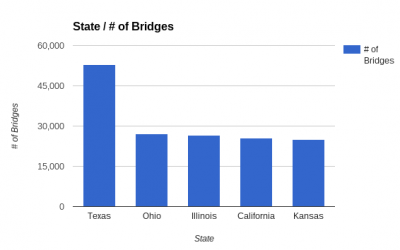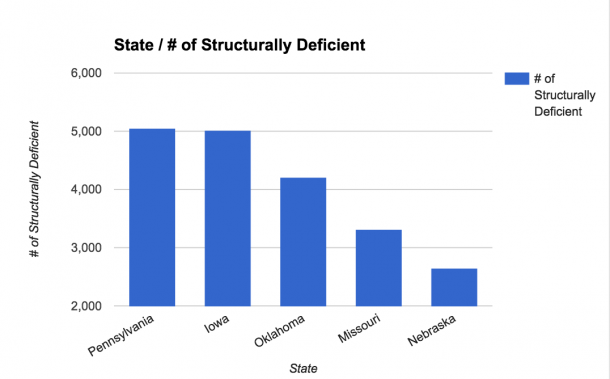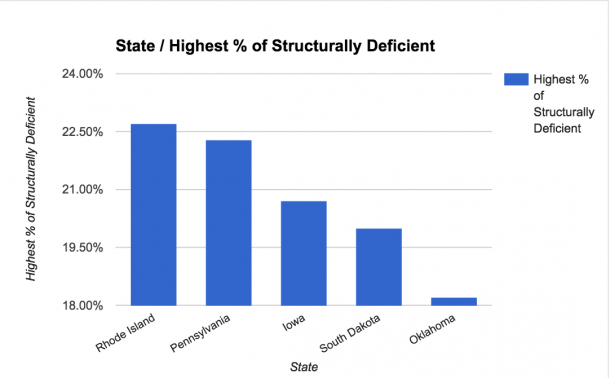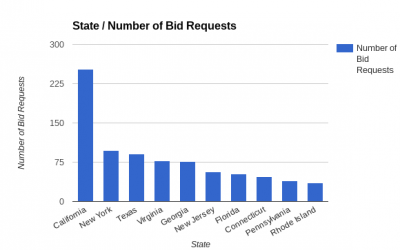Are Governments Addressing Deficient National Bridge Infrastructure?
In the United States today, there are well beyond 600,000 bridges. With a little research, we uncovered a startling statistic associated with our bridge infrastructure. Depending on the estimates to which you subscribe, roughly 10% of the bridges are considered to be “structurally deficient”. By the end of 2014, as reported by the Federal Highway Administration, 61,064 bridges in the U.S. will have been deemed structurally deficient.
Delving deeper into this subject matter, I questioned, “What does ‘structurally deficient’ really mean?” It is a frequent term used throughout this review, and one of the straightforward answers I found to address this inquiry was from Aspire – The Concrete Bridge Magazine:
“Structurally Deficient’ is the term created by bridge engineers to indicate that a bridge is in need of maintenance, rehabilitation, or sometimes replacement. As a bridge ages, parts of the bridge deteriorate to where it becomes necessary to repair or replace the deteriorated parts or, in some cases, the entire bridge. To check for these conditions, trained bridge engineers inspect bridges every 2 years or more frequently to be sure they are safe for the designated loads. If they are not, the bridges are posted for the restricted loads that they can safely carry or are closed until they can be fixed or replaced.”
Based on the data through EOY 2014 and reports from the U.S. Department of Transportation, the number of bridges considered to be “structurally deficient” or “functionally obsolete” is, in a word, disturbing. As we did in preparing this analysis, refer here for a variety of applicable data reported by states, federal agencies, and tribal governments.
As we approach the somber anniversary of the August 1st, 2007 structural failure and collapse of the I35W bridge in Minneapolis in which there were 13 fatalities, there is still a wide chasm between need and action. In addition to the 2007 tragedy in the Twin Cities, there have been 17 other documented U.S. bridge failures since 2000. With the above information in hand, we had a springboard to researching and analyzing where the U.S. stands today. We will leave it to you to determine if what follows is an adequate reaction to this substantial need.
In more troubling news: according to information from the American Road and Transportation Builders Association, there are over 215 million daily crossings on the structurally deficient bridges in need of repair. As you will see below, the problems are not isolated to a specific area, state, or region.
Are you interested in cranking up a heated debate? Bring up the topic of the highway trust fund and/or transportation funding. What is needed to repair the bridges? Reviewing the projections from a variety of sources reveals a price tag in the neighborhood of $1 trillion. The clock is ticking, and some suggest it’s time for a little creativity. In today’s U.S. News and World Report, Jason Gold, COO for the McGraw Hill Financial Global Institute and an adjunct professor at Georgetown University, suggested an approach that combines public and private sector resources. The 60,000 U.S. bridges are spread throughout the nation.
Earlier this month, the U.S. Department of Transportation acknowledged that we have a growing infrastructure problem and time is not on our side. Here is ‘We Must Invest in America’s Transportation Future’.
States with highest number of bridges considered to be “structurally deficient”. Our nation’s capital, the District of Columbia has the fewest number (14) of bridges designated.

States with highest % of bridges considered to be “structurally deficient”. While Texas has the most bridges, it has the third lowest percentage (2.1%) of bridges designated.

Mr. Geoffrey Anderson, President and CEO of Smart Growth America, pointed out as a guest on InfrastuctureUSA’s, The Infra Blog, that infrastructure needs more than just a band-aid. As you will hear, Mr. Anderson has some compelling opinions on an assortment of topics related to the subject matter.



Sample Active Bids/RFPs
Bridges
For more information about this study, related-bids, or any other industry, call us at 888.808.5356, or visit BidPrime.
